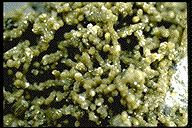 THE
MINERAL HYDROXYLBASTNASITE
THE
MINERAL HYDROXYLBASTNASITE
 THE
MINERAL HYDROXYLBASTNASITE
THE
MINERAL HYDROXYLBASTNASITE- Chemistry: (Ce, La, Nd)CO3(OH, F) , Cerium Lanthanum Neodymium Carbonate Hydroxide Fluoride.
- Class: Carbonates
- Groups: Rare earth carbonates and Bastnasite.
- Uses: As an important ore of cerium and other rare earth metals and as mineral specimens.
Specimens
Hydroxylbastnasite is closely related to its near namesake bastnasite. Hydroxylbastnasite has in its formula and structure hydroxyl ions, OH, that bastnasite lacks, hence the name. The hydroxyl ion groups take the place of most of the fluorines that are found in bastnasite. X-ray studies confirm that the hydroxyl ion groups dramatically increase the unit cells of hydroxylbastnasite structure from that of bastnasite's structure. Crystallographically and mineralogically this is significant. Significant enough to proclaim Hydroxylbastnasite as a unique mineral.
A new proposed mineral has recently been named from specimens that contain all hydroxides and no or very few fluorines.
The proposed mineral has a formula of (Ce, La, Nd)CO3OH and is call
The structure of the three minerals is made up of stacks of carbonate ion layers and Ce(OH, F) layers. The Ce(OH, F) layers form flat hexagonal sheets with each cerium bonded to three fluorines and visa-versa. The carbonate layers are more complex with angled carbonate triangular groups. The structure is closely studied because it is one of the few rare earth mineral structures that can accommodate variously sized cations.
Hydroxylbastnasite (also spelled hydroxyl-bastnasite) has cerium, lanthanum and neodymium in its generalized formula but officially the mineral is divided into three minerals based on the predominant rare earth element found in specimens. There is Hydroxylbastnasite-(Ce) with a more accurate formula of (Ce, La)CO3(OH, F). There is also Hydroxylbastnasite-(La) with a formula of LaCO3(OH, F). And finally there is Hydroxylbastnasite-(Nd) with a formula of (Nd, Ce, La)CO3(OH, F). There is little difference in the three in terms of physical properties and most hydroxylbastnasite is hydroxylbastnasite-(Ce). Cerium in most natural hydroxylbastnasites usually far and away dominates the others. Hydroxylbastnasite is an ore of cerium, an important industrial metal, but is far behind bastnasite and the phosphate mineral monazite as a source of the rare earth element.
Hydroxylbastnasite is an important ore in the unusual karst, rare earth/nickel-rich/bauxite deposits in Montenegro, Greece and other deposits in the Balkans. These deposits are depleted in fluorine and this the primary reason that hydroxylbastnasite and not bastnasite forms. Hydroxylbastnasite is also found to a lesser extent as a primary mineral in carbonate rich igneous rocks called carbonatites.
PHYSICAL CHARACTERISTICS:
- Color is pale white, yellow or brown.
- Luster is vitreous, greasy to dull.
- Transparency: Crystals are translucent to opaque.
- Crystal System is hexagonal.
- Crystal Habits include small hexagonal rounded platy crystals forming rosettes and short prismatic crystals. Also found in masses and grains.
- Hardness is 4.
- Specific Gravity is 4.7 to 4.8 (well above average)
- Streak is white.
- Associated Minerals include
hydroxylcarbonate , bastnasite,donnayite , calcite,ewaldite and several bauxite minerals. - Notable Occurrences include the Kola Peninsula, Russia; Niksic, Zagrad and Stitovo, Montenegro; Nisi, and Marmeiko nickel rich bauxite deposits, Greece; and several other sites in the Balkans.
- Best Field Indicators: crystal habit, color, density, luster and locality.








